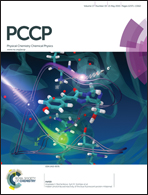Functional carbon nanotubes for high-quality charge transfer and moisture regulation through membranes: structural and functional insights
Abstract
Functional single walled carbon nanotubes (SWCNTs) are assembled onto porous supports by using layer-by-layer (LBL) approaches. Directed nano-assembly of nanotubes is identified as a crucial factor for controlling the combined functions of hybrid-composite membranes, including charge and moisture transport. In both the cases, donor–acceptor interactions are indicated to be responsible for the rearrangement of nanotubes inside the LBL multilayer and their related properties. Aggregation and stratification of the carbon nanotubes along with the availability of selective-site interactions are complementarily investigated by using SEM, Raman and infrared spectroscopy, while high electrical charge and water vapor transfer are achievable, provided that a large number of connections and competitive interactions are allowed. Ohmic behavior is observed for all types of carbon nanotubes, even if better-quality charge transfer pathways are obtained with carboxylated conductive filaments. Likewise, assisted moisture regulation is succeeded when using functional filaments with the capability to establish competitive H-donor–acceptor interactions with water.


 Please wait while we load your content...
Please wait while we load your content...